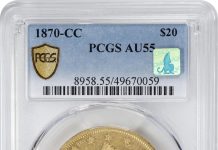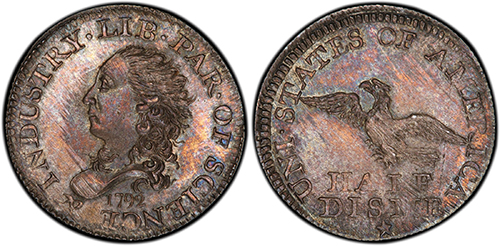
By Barry Sunshine
There are some great opportunities as well as areas for caution for collectors and investors in Bust coinage. I know I’m supposed to write about the “gotta-have” coins. But in identifying those specimens of value appreciation promise, I came across others where it isn’t so clear that they will soon appreciate. So you might not have to have them, even though at first glance you might want them.
I have been collecting Bust coins for over 30 years and developed a deep passion for U.S. Bust silver coinage, specifically Bust half dimes and dimes. I attend local, regional, and national coin shows and follow auctions tracking these coins and carefully following their trends. Also, I communicate regularly with collectors and dealers, and I carefully keep track of their observations and experiences.
So after synthesizing all of this information, here are my “gotta haves” and “not haves” in Bust half dimes.
Bust Silver’s Interesting Origins
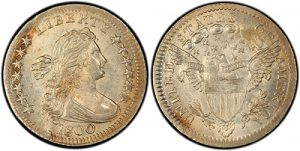
Bust half dimes were minted from 1792 through 1837, and they had three very different designs. The first year for half dimes was 1792, and these coins are referred to as “half dismes.” For some numismatists, these coins are considered to be pattern coins, while other collectors believe that these coins should be considered part of the Bust half dime series. Either way, the 1792 half disme is a coin widely appreciated by investors and collectors.
It is estimated that only 200 to 300 examples exist; so they are not commonly collected but widely appreciated. Also, these half dismes are closely tied to the U.S. beginnings. Most of these coins exist in circulated condition, and when offered for sale don’t stay on the market for long periods of time. Based on estimates, there are fewer than 40 known examples in uncirculated condition, and they trade at $200,00 and more.
The 1792 half disme should see a slight increase in value for those coins graded Good to Extremely Fine. For those uncirculated examples, I expect them to be flat in price unless they are very attractively toned, making them high in eye appeal. Examples that meet the high in eye appeal standard could increase in price by 5% over the next couple of years. Those examples are highly sought by collectors and investors whenever offered and typically attract attention.
Trio of Types
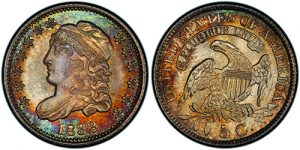 The early half dimes were minted from 1794 until 1805 and had three different types: 1794 and 1795, referred to as the Flowing Hair design; 1796 and 1797, referred to as the Draped Bust Small Eagle reverse; and 1800 to 1805, referred to as the Draped Bust Heraldic Eagle reverse. These early half dimes are collected by investors, type collectors, and half dimes specialists. 1802 is the key date of this series, and it is offered very rarely.
The early half dimes were minted from 1794 until 1805 and had three different types: 1794 and 1795, referred to as the Flowing Hair design; 1796 and 1797, referred to as the Draped Bust Small Eagle reverse; and 1800 to 1805, referred to as the Draped Bust Heraldic Eagle reverse. These early half dimes are collected by investors, type collectors, and half dimes specialists. 1802 is the key date of this series, and it is offered very rarely.
The half dime specialists are truly dedicated to collecting half dimes and are the foundation of this series. Besides these specialists, most investors and type collectors acquire one example from any of these groups. Most half dimes dated from 1794 to 1805 are cleaned and not attractively toned. For the last several years, these half dimes have slowly decreased in value. Also, there exists a good number of examples of these coins in all grades to satisfy demand. The only exception is the 1802, which will attract attention when offered.
As for the values of the 1794 to 1805 half dimes, I expect a very slow increase in value in all grades. However, only those that are not cleaned and reflect even wear will achieve this growth. Any examples that are harshly cleaned and damaged will continue their slow downward spiral.
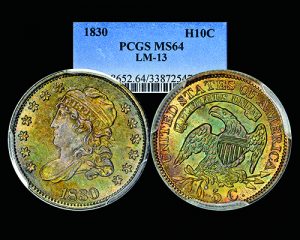
Capped Bust half dimes were minted from 1829 until 1837 and have only one design. The Capped Bust half dimes are fairly easy to collect. There are many dedicated Capped Bust half dime collectors who collect these coins by major variety or by die variety. It usually takes many years for those dedicated specialists to complete their collections, and many feel that they never complete their collections. They support the market for the values.
I expect the values of the Capped Bust half dime series to experience a very slow increase in value in grades from Almost Uncirculated and higher. Also, very rare die marriages (rarity 4 and higher) will increase as well but are rarely offered. One area that I expect can offer a nice appreciation in price are those Capped Bust half dimes ranging in grades from Almost Uncirculated through Gem Uncirculated that are very high in eye appeal and sport gorgeous toning. Further, some of them might be scarcer die marriages that have not been attributed. For those examples offered in auction or by dealers without much fanfare, collectors can cherry-pick these coins and achieve a handsome, quick return ranging from 10% to 20%. Those are coins you should buy instantly.
Early half dimes are under appreciated, and if more collectors get interested in this series, prices will increase. The coins with the greatest potential are those with strong eye appeal and gorgeous toning. If you can find any of these coins in a high grade, you “gotta have them.”




